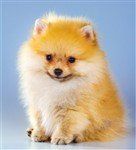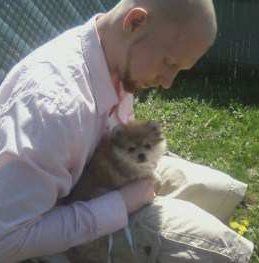Aggressive
PetPom

The
Pomeranian
Information
Center
Pomeranian Aggression Issues
Overview
This breed generally has a very loving
personality and naturally friendly
behavior. The Pom, throughout generations, has always been a companion lap dog...
Therefore it is in the bloodlines to not be combative or have strong guarding instincts (although some can be protective of their humans despite their own diminutive size).
Even when you look back into the origin of this breed, the Pomeranian's ancestors, large Spitz dogs, were gentle sled dogs.
With this all said, every breed that exists is, technically, capable of being aggressive, even if it is rarely seen.
Then, comes the question of, what defines aggression with a Pomeranian?


Angel, photo courtesy of Lora Vadasan
Is it growling? Barking? Nipping? It is taking an aggressive stance or must the dog attempt to bite?
Well, for the Pomeranian all of these actions could be described as some sort of aggression, depending on the circumstances and how owners feel.
In addition, growling or trying to nip at someone will seem much more severe if this is directed at a young child or elderly adult.
Reasons for Aggression
Most owners who worry about their Pomeranian being aggressive are just as shocked as they are concerned. And it can seem confusing about why a puppy or dog is suddenly acting out of control.
The most common reasons for acting aggressively are:
Fear - Poms can be afraid of many things, from loud noises, to strangers (both human and canine), to chaotic situations.
This can make a dog take an offensive stance, and then this can manifest outwardly by growling, nipping and even trying to bite people.
Improper Status -
When a dog is aggressive towards human family members, this is often a sign that the dog is confused about his place in the hierarchy of the family.
Health Issues -
When any dog that is normally well behaved suddenly becomes aggressive, this may be because the dog is suffering some type of health
issue. When a dog is in pain, he may nip, snarl, growl, or even bite.
This is due to feeling vulnerable, which can cause a dog to lash out at those who are perceived as threats to him while he is in a weakened state.
For this reason, before you start working on training to stop aggression, your Pomeranian should have a full veterinary examination.
Can Aggression be Fixed?
Some wonder if an aggressive dog is somehow unstable or otherwise dealing with emotional issues to such a point that the problems cannot be resolved. And this sort of thought is most often seen with older, adopted Poms.
The answer to the question of 'can this be resolved?', is that it really all depends.
It depends on the extent to which a Pom is displaying aggressive behavior, what he is doing, how often the events occur, the owner's capability to train for this issue, and if it is feasible for a professional trainer to become involved, should it be warranted.
Aggression Toward Strangers
It is natural for a dog to be verbally aggressive (to some degree) toward true strangers, those who may come to your home to sell you something for example... and having your Pomeranian alert you to these types of strangers is not necessarily a bad thing.
In the case of a break in, your Pom''s barking may just scare off an intruder.
If you are having a problem that involves barking only, you will want to read over the Pomeranian barking problems
section.
For other sorts of issues including nipping at, jumping at, or acting out-of-control with visitors to the home, this will be covered ahead.


With Young Children and Senior Adults
When a Pomeranian is showing aggressive tendencies, it is not uncommon for this to be directed toward young children or senior adults.
For example, a Pom may growl at a toddler when she gets too close to his toys, nip at an older adult as he walks across the room, or take an aggressive stance toward a young child when she tried to pet him.
While training can help in many cases, it must be noted that if you feel that anyone in the household may be in danger (which would involve actual biting), either a professional trainer must be brought in right away (and the dog segregated until that time), or the dog should be re-homed.
Not only is danger a concern, but also a young child or older adult may not be able to be involved with the training.
Training to Stop Aggression Displayed at Home
Before we Begin
First, as we mentioned earlier, you will want to be positive that your Pomeranian does not have any health issues since this can trigger aggressive behavior.
You will also want to be sure that everyone in the household is willing to be involved and is able to (based on age).
Prepping for Training
To prepare for this, you will first want to have a designated 'time out' area for your Pomeranian. During certain points of training for aggression, this is a 'must', so you will need to have this before you start.
An indoor canine playpen like the IRIS 24'' 4-Panel Pet Playpen with Door
 often works best; though blocking off a section of a room with gates may work as well. You will want the chosen area to be near the rest of the family and not isolated away from things. The kitchen or living room is often a good choice.
often works best; though blocking off a section of a room with gates may work as well. You will want the chosen area to be near the rest of the family and not isolated away from things. The kitchen or living room is often a good choice.
#1 Teaching Proper Hierarchy
Barring any health issues, or deep-set reasons for aggression such as past abuse, most Pomeranians that are aggressive toward a family member lack an understanding of proper hierarchy.
And for those showing aggression towards visitors to the home, but not listening to their owners commands to stop, are most likely also not understanding proper hierarchy.
In the canine world, within the den (house) where the pack (family) resides, there is a leader(s) (Alphas) and all other members of the pack are the followers (Betas).
The betas respect the alpha, rely on the leader for food (which a dog understands to be the very means of his survival), and would never be disrespectful to him or her.
So, growling, nipping at, or otherwise acting aggressive toward a human means that the Pomeranian is not seeing that person as his leader. He may see them as his peer, or even lower.
Therefore, teaching a dog all about who is in charge can often lead to a reversal of behavior.
There are 3 basic parts to this:
1.
A 'Sit' must first be obeyed any time that food is given. This includes both meals and snacks.
2.
When leaving the house or coming back in, all humans go first, followed by the dog.
3.
In cases of severe aggression, humans are always at a higher physical level than the offending dog. This means that at all times until the problem is fixed, humans do not sit on the floor with the dog. And the dog is not allowed to be up on the sofas or on their human's beds.
#2 Your Immediate Reaction
Any time that your Pomeranian makes an aggressive action, he should immediately be placed in his time-out area as mentioned earlier.
Going back to how canines perceive their world, if someone in the pack (family) commits a serious enough offensive, they are banished from the pack.
So, the idea of this is to make a very strong statement that banishment is indeed on the table.
During the time-out, it is very important that no one speaks to the Pom, or even look at him. It can take puppies or dogs anywhere from 2 minutes to 15 to realize that they are being ignored. When you believe that he has realized this, wait another 5 minutes.
#3 Slow Introduction Back
Once the Pomeranian has realized that he is being banished (at least temporarily), he can be let out and placed in the exact same situation as before when he acted out. For example, if he was in the living room and had nipped at someone's ankles, place him there and have that person walk across the room again.
If at any time he acts aggressive again, he is immediately given a time-out again.
If he does not act out, he is spoken to, but not petted or played with.
If he continues to act appropriately, he may be petted or even given a treat after another 5 to 10 minutes.
You may find that you need to repeat the time-outs quite a bit. It can take days of this for a dog to really start to understand that his aggressive behavior will not be tolerated. And, this must all be done in conjunction with the other steps of how the food is given, how everyone enters and exits the house, and how others place themselves in relation to the dog.
If Training Does Not Work
Training of any type does not work for every dog, and this is true for this as well.
There may be underlying issues that owners are not aware of. Or, the reasons for the aggressive behavior may be more deep-seated than thought.
In some cases, owners are not able to train as much as needed for a particular dog's problems.
If you do not see any progress within just a few days, or if things are getting worse, it will be time to bring in a professional trainer. If aggression issues are happening mainly inside the house, you will want a trainer who will come to your house to work with you.
Your local SPCA may be able to refer you to qualified canine behavioral trainers within your area.
Until that time, if there is any danger that the Pom may bite, cause harm, or even if youngsters or others feel unsafe or uncomfortable, keep the Pom within his playpen and always controlled on leash when outside of it.
__1426102818_73-243x326.dm.edit_u5d99l.17.32.39-1920w.jpg)
__1426102818_73-243x326.dm.edit_u5d99l.17.32.39-1920w.jpg)
Teddy, 10 months old
Photo courtesy of owner: Titi
Training for Aggression Toward Visitors to the Home
With short, acute instances
of your Pomeranian barking at the mailman or other such things, in most cases this is best left alone. As long as your dog calms down once that person has left the property, all should be fine.
If you approve of your little Pom protecting the home as a 'watch dog' you can say "good dog", give a pat and then show that all is well by resuming the day and speaking in a matter-of-fact manner.
With problematic aggression towards visitors that come inside the house,
this is a different matter.
Prepping
First, be sure that you are following the steps for teaching proper hierarchy, because your Pomeranian will not listen to you if he does not see you as his leader. You will also want to have the time-out area set up, as explained earlier.
Training
1.
You will need helpers for this. Try to round up friends, neighbors, and family members that your dog is not used to. Explain to them that you will be starting a training program for your dog and see if they will agree to take turns in helping you with this.
2. Once you begin training your Pom, it should be done every day until the training is complete.
3. This will begin by having someone arrive at your home. Whoever arrives should have dog treats in their pocket. When you know that your helper is going to enter, have your Pomeranian sitting down beside you, with his leash on.
4.
Open the door and show your Pomeranian that you approve of the visitor. This is done with calm words and slow actions. Greet your visitors without any tension.
5.
The idea of this is that any unacceptable behavior is immediately responded to with a time-out as described earlier, with the Pom within sight of everyone, but being 100% ignored. And any good behavior will be immediately rewarded with a treat and praise.
Here are the key points:
- Any time that your Pom shows aggression, place him in his playpen or gated off area.
Then, implement social isolation for 5 to 15 minutes. This means that you must ignore your dog completely. Do not say "bad dog", do not say his name, do not talk to him. Simply continue a calm conversation with your visitor.
- After the 5 to 15 minutes, attempt to have your dog interact with your helper again.
- If he behaves nicely, you will give the first treat. If after 5 minutes, he continues to behave, your helper will give the next treat.
- Each action, good or bad, must be acted upon with either praise or temporary banishment.
- Have the 1st visit last for about 10 minutes. Have different helpers come to visit on different days. Increase the visits by 5 minutes per day until the maximum time of 30 minutes.
By following this method, improvement should be seen within 1 to 2 weeks, depending on how often you are able to implement the training.
Training Tips for Aggression Toward Other Dogs
Aggression toward other dogs can severely interfere with walks for daily
exercise, trips to the vet, and so much more.
Prepping
Try to find a friend, co-worker, neighbor or family member who already has a well behaved dog. Set up a play date.
Know that not much will be accomplished in one day. This type of training must be instilled repeatedly and rushing this will surely lead to failure. Having patience will help ensure success.
Both dogs should be on leash and be sure that your Pom has a
harness on. Because part of this training for dog-to-dog aggression may involve quickly pulling your Pom away from the interaction, this can cause injury to the neck if your Pom is on leash and collar.
Have your helper come with treats already in their pocket, and you will have treats as well.
Since dogs are often very protective of what they consider to be their territory, you will want the first interactions to be held outside of your house. Your yard (away from your Pom's bathroom area) or a common area will be fine.
Only after your Pomeranian has proven himself to behave well around other dogs, should you then move training to inside your home (and in some cases, this is not needed at all).
Training
Have your Pomeranian in a 'Sit'. When the other dog is led over to you, talk in a calm manner. Allow the dogs to sniff each other.
If your Pom barks wildly or acts aggressive toward the other dog, he should be taken back via the leash (approximately 10 feet or so) and then 100% completely ignored. You should not say his name, pat him, or speak to him.
Once barking has stopped -and it will, it is a matter of 'waiting out the dog'- then walk your Pom to the other dog again.
Each time your Pom acts aggressive, lead him away to distance him from all involved, while ignoring all barking or attempts to gain attention. This teaches a dog that there will be zero interaction, zero attention, and certainly no fun when aggression is displayed.
Each time your Pom behaves well in the presence of the other dog, give praise every minute or so. Give both dogs treats. And continue to keep an eye on both.
The first 'play date' should only last about 10 minutes as not to overwhelm and to end the session on a good note.
Each day, try to increase this time by 5 minutes.
If possible, this will work best if after a few days, you can introduce other dogs as well so that your Pomeranian becomes used to all types of dogs, big and small. Consistency is the key to this training.
If your dog does not respond to these training methods, the aggression may run very deep and it is highly recommended to find an experienced dog trainer who can work with your Pomeranian one-on-one.
If you email photos to us, you agree that PetPom is given free copyright to use at our discretion. We will always credit the photo to the name of the Pom's owner(s) if it is supplied.
Email: Contact@PetPom.com
All text, images and artwork protected by US and International copyright laws. All rights reserved. Copyright PetPom.com
We are a participant in the Amazon Services LLC Associates Program, an affiliate advertising program designed to provide a means for us to earn fees by linking to Amazon.com and affiliated sites.


